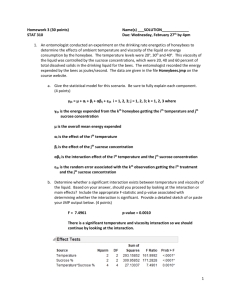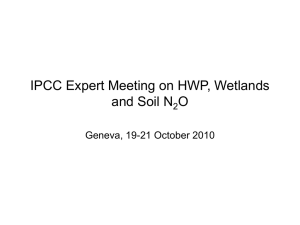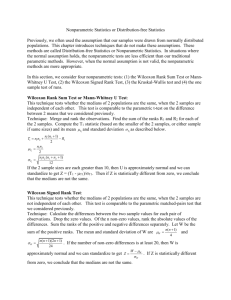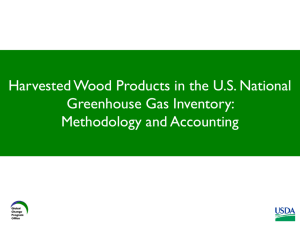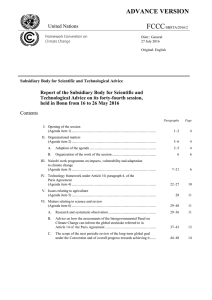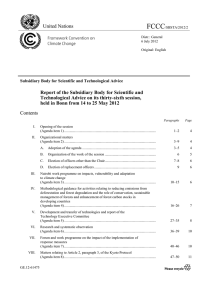IPCC Third Assessment Report (TAR) Climate Change 2001
advertisement
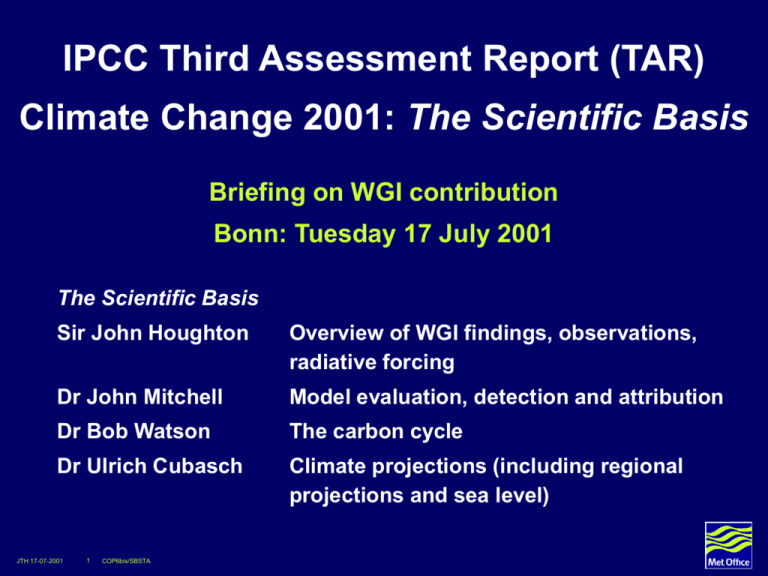
IPCC Third Assessment Report (TAR) Climate Change 2001: The Scientific Basis Briefing on WGI contribution Bonn: Tuesday 17 July 2001 The Scientific Basis Sir John Houghton Overview of WGI findings, observations, radiative forcing Dr John Mitchell Model evaluation, detection and attribution Dr Bob Watson The carbon cycle Dr Ulrich Cubasch Climate projections (including regional projections and sea level) JTH 17-07-2001 1 COP6bis/SBSTA IPCC Website http://www.ipcc.ch JTH 17-07-2001 2 COP6bis/SBSTA Structure of IPCC 1997 - 2001 United Nations WMO UNEP World Climate Programme IGBP Global Climate Observing system etc Subsidiary bodies of the framework convention on climate change IPCC IPCC Bureau WGI Science WGII Impacts and adaptation WGIII Mitigation Lead Authors, Contributors, Reviewers JTH 17-07-2001 3 COP6bis/SBSTA COP/FCCC Climate Change 2001: The Scientific Basis WGI contribution to IPCC Third Assessment Report Summary for Policymakers (SPM) Drafted by a team of 59 Approved ‘sentence by sentence’ by WGI plenary (99 Governments and 45 scientists) 14 chapters 881 pages 120 Lead Authors 515 Contributing Authors 4621 References quoted JTH 17-07-2001 4 COP6bis/SBSTA JTH 17-07-2001 5 COP6bis/SBSTA Key steps in preparation of Working Group I (science) component of Third Assessment Report Bad Munsteriefel Scoping Meeting Vienna Shanghai VII WORKING GROUP I SESSION VIII Paris 1 LEAD AUTHORS MEETING Arusha 2 Auckland 3 Victoria 4 Shanghai 5 New York TS / SPM DRAFTING INFORMAL REVIEW EXPERT REVIEW GOVERNMENT REVIEW 1998 JTH 17-07-2001 6 COP6bis/SBSTA 1999 2000 2001 What is global warming about ? JTH 17-07-2001 7 COP6bis/SBSTA Variations of the Earth’s surface temperature for the past 140 years SPM 1a JTH 17-07-2001 8 COP6bis/SBSTA Variations of the Earth’s surface temperature for the past 1,000 years SPM 1b JTH 17-07-2001 9 COP6bis/SBSTA Concentration of Carbon Dioxide and Methane Have Risen Greatly Since Pre-Industrial Times Carbon dioxide: 33% rise BW 5 The MetOffice. Hadley Center for Climate Prediction and Research. JTH 17-07-2001 10 COP6bis/SBSTA Methane: 100% rise 700 CO2 in 2100 (with business as usual) Double pre-industrial CO2 500 Lowest possible CO2 stabilisation level by 2100 400 CO2 now 300 10 Temperature difference 200 0 from now °C –10 100 160 120 80 Time (thousands of years) JTH 17-07-2001 11 COP6bis/SBSTA 40 Now CO2 concentration (ppmv) The last 160,000 years (from ice cores) and the next 100 years 600 The Greenhouse Effect Solar radiation Long-wave radiation JTH 17-07-2001 12 COP6bis/SBSTA The Enhanced Greenhouse Effect Solar (S) and longwave (L) radiation in Wm-2 at the top of the atmosphere S 236 L 236 S 236 L 232 S 236 L 236 T = -18°C TS = 15°C JTH 17-07-2001 13 COP6bis/SBSTA CO2 x 2 CO2 x 2 TS = 15°C DTS ~ 1.2K S 236 L 236 CO2 x 2 + Feedbacks H2O (+60%) Ice/Albedo (+60%) Cloud? Ocean? DTS ~ 2.5K Variations of the Earth’s surface temperature; 1000 to 2100 JTH 17-07-2001 14 COP6bis/SBSTA The Carbon Cycle JTH 17-07-2001 15 COP6bis/SBSTA Human Perturbation of the Carbon Cycle JTH 17-07-2001 16 COP6bis/SBSTA Partitioning of CO2 uptake using O2 measurements JTH 17-07-2001 17 COP6bis/SBSTA Changing Land Use Changing land use could influence atmospheric CO2 concentration. Hypothetically, if all of the carbon released by historical land-use changes could be restored to the terrestrial biosphere over the course of the century (e.g., by reforestation), CO2 concentration would be reduced by 40 to 70 ppm. JTH 17-07-2001 18 COP6bis/SBSTA Radiative Forcing JTH 17-07-2001 19 COP6bis/SBSTA SPM 3 JTH 17-07-2001 20 COP6bis/SBSTA Estimated solar irradiance variations 1750-2000 JTH 17-07-2001 21 COP6bis/SBSTA Main climate changes JTH 17-07-2001 22 Sea level rise Higher temperatures - especially on land Hydrological cycle more intense Changes at regional level COP6bis/SBSTA Sea-level transgression scenarios for Bangladesh Adapted from Milliman et al. (1989). JTH 17-07-2001 23 COP6bis/SBSTA Percent of the continental USA with a much above normal proportion of total annual precipitation from 1-day extreme events (more than 2 inches or 50.8mm) BW 7 Karl et al. 1996 JTH 17-07-2001 24 COP6bis/SBSTA Patterns of Climate Response JTH 17-07-2001 25 COP6bis/SBSTA The 1997/98 El Niño Strongest on Record* El Niño years La Niña years BW 14 *As shown by changes in sea-surface temperature (relative to the 1961-1990 average) for the eastern tropical Pacific off Peru JTH 17-07-2001 26 COP6bis/SBSTA Global ocean circulation Cooling Warm surface current Intermediate waters Warm and less saline Antarctic circumpolar current A simplified view of the global thermohaline conveyor belt, showing cooling and downwelling in the North Atlantic, warming and freshening in the southern hemisphere, and return flow as a warm surface current. JTH 17-07-2001 27 COP6bis/SBSTA Stabilisation of Climate JTH 17-07-2001 28 COP6bis/SBSTA UNITED NATIONS FRAMEWORK CONVENTION ON CLIMATE CHANGE Rio de Janeiro : June 1992 ARTICLE 2: OBJECTIVE The ultimate objective of this Convention .... is to achieve, .… stabilization of greenhouse gas concentrations in the atmosphere at a level that would prevent dangerous anthropogenic interference with the climate system. Such a level should be achieved within a time-frame sufficient : JTH 17-07-2001 to allow ecosystems to adapt naturally to climate change. to ensure that food production is not threatened, and to enable economic development to proceed in a sustainable manner. 29 COP6bis/SBSTA JTH 17-07-2001 30 COP6bis/SBSTA CO2 emissions for SRES and stabilisation scenarios JTH 17-07-2001 31 COP6bis/SBSTA JTH 17-07-2001 32 COP6bis/SBSTA JTH 17-07-2001 33 COP6bis/SBSTA JTH 17-07-2001 34 COP6bis/SBSTA JTH 17-07-2001 35 COP6bis/SBSTA JTH 17-07-2001 36 COP6bis/SBSTA JTH 17-07-2001 37 COP6bis/SBSTA JTH 17-07-2001 38 COP6bis/SBSTA JTH 17-07-2001 39 COP6bis/SBSTA
